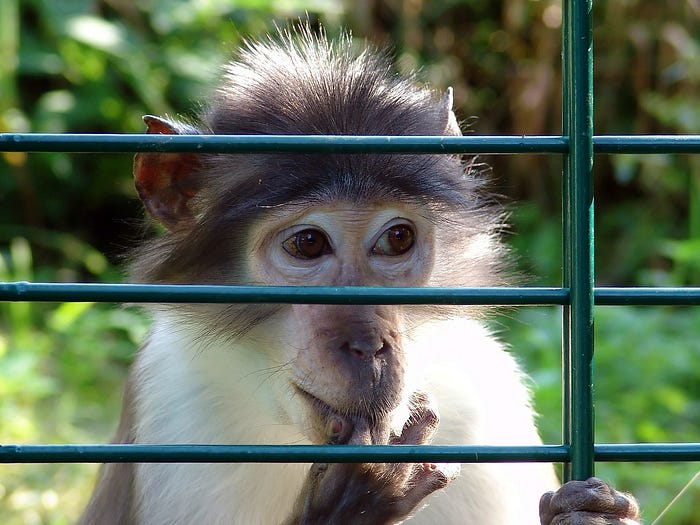No Monkey Business:
How Primates Have Helped in the Fight Against HIV

Deep in the forests of Senegal, a small, curious looking monkey lives peacefully among the trees. Thus it may be surprising to know that this small primate may hold the key to save millions of people’s lives across the world. What makes the Sooty mangabey so unique is not its characteristic white collar, but rather its apparent resistance to HIV, which is helping researchers test new anti-HIV therapies.
Since 1981, HIV has been the cause of over 39 million deaths. What kills, however, is not the virus itself, but its third stage, commonly known as AIDS. In the first two stages, the virus lives inside the body, but there are no noticeable symptoms. During the third stage, however, the virus kills many of the body’s white blood cells. These cells are vital for your immune system, and their absence leaves people with AIDS incredibly vulnerable to common, normally non-life threatening diseases.
The Sooty mangabey, however, does not seem to follow this pattern described above. When infected with the primate version of HIV — called SIV, or Simian immunodeficiency virus — the Sooty does not develop AIDS but rather coexists with the virus and develops no dangerous symptoms. Other primates, such as the Rhesus macaque, do develop AIDS once they’re infected with SIV. What causes these contradicting responses? This is what scientists are currently researching in primates.
The key to finding the cause of these differences between the two species is genomics. Recently, through new genetic sequencing technologies, the genomes of these two primate species were fully sequenced. This revealed something very interesting to researchers. It seemed there was a significant difference between the two species, in the gene known as TLR 4. This gene protects against bacterial infections through inflammation. What does this have to do with HIV, however? What really causes HIV to progress to AIDS is the elimination of your white blood cells, specifically a certain type called CD4+T cells. Normally, it takes many years after the initial infection for your CD4+T cells to begin to disappear. This is only in your blood, however. In your intestines these cells are actually wiped out in days. The TLR 4 gene sees the virus as a bacterial infection, and tries to stop this by causing inflammation in your gut. This inflammation does nothing to stop the virus, and instead it causes your intestines to weaken, and eventually rupture. This allows the virus to spread from your intestines into your bloodstream, and thus the rest of your body. This then results in AIDS. The Sooty mangabey was found to have a mutation in this gene which stopped inflammation, and thus stopped the virus from progressing to AIDS.
Because of their resistance to AIDS, sooty’s are used by scientists as models of the immune system’s response. As Dr. Steven Bosinger, Director of the Yerkes Nonhuman Primates Genomics Core at Emory, says, “they’re not good model for studying how a vaccine would work, but they are a good model for studying the differences in the immune system between species that do get sick, like humans.” In order to test vaccines and other therapies, scientists use the Rhesus macaque. This primate’s genome is incredibly similar to the human, more so than mice. Like humans, they also do not have the HIV resistant gene that is present in primates such as the sooty. As stated by David Evans and Guido Silvestri in their scientific paper on AIDS Primate research, “the biological similarities between human and simian AIDS…are such that many consider the SIV/macaque model the most useful animal model ever developed in biomedical research.”
Using a hybrid version of the HIV virus, called SHIV, or simian HIV, scientists infect macaques and then test various vaccines to see how effective they are. By studying the way the immune system responds to HIV in both sooty’s and macaques, the scientists can then tailor the vaccines to target different parts of the system. Thus, these primates offer vital ways to not only study the virus, but also to test new vaccines and therapies.
After nearly forty years since its initial diagnosis, HIV seems to be no closer to being cured. Primates, however, hold the key. Through extensive experiments, scientists are able to use primates as effective models to study ways to stop the virus. Additionally, primates, such as the Sooty mangabey, offer incredible examples of nature’s own methods of combating the virus. One must remember that in fighting HIV, we are fighting the result of millions of years of evolution in nature. Thus, it seems fitting to look in nature to find a cure, which may save millions of people to come.
